
In the high-end manufacturing sector, where precision and reliability are non-negotiable, selecting the right CNC milling machine can make or break production efficiency and part quality. Over nearly two decades of experience supporting global buyers, it’s clear that many stumble over machine stability and tool wear when processing large, complex components. Understanding why double column CNC milling machines, especially the GV1625 model, have become the industry’s go-to solution sheds light on their unique value proposition.
At the heart of the GV1625’s exceptional performance lies its robust double column framework, constructed from high-strength steel with precision welding and stress-relief treatments. Unlike conventional single-column designs that suffer from lateral deflection during heavy-duty cutting, the double column architecture provides symmetrical support on both sides of the worktable. This dramatically enhances rigidity, minimizing vibrations and deflections that typically compromise machining accuracy.
This design stability can be quantitatively assessed: in comparative tests, the GV1625 exhibits a bending stiffness increase of up to 40% versus traditional single-column machines of similar size, translating into tolerances maintained within ±0.005 mm during complex milling cycles. Such rigidity ensures consistent tool paths and surface finishes, critical when working on intricate aerospace or automotive parts.

The principle of stable cutting revolves around minimizing dynamic load fluctuations during the milling process. When a machine wobbles or vibrates, the cutting tool experiences uneven forces, accelerating wear and risking premature failure. The GV1625’s double column design ensures that cutting forces are evenly absorbed and distributed, drastically lowering vibration amplitudes.
Practically, this stability means longer uninterrupted cutting cycles and reduced tool replacements. Our most recent case involved a European precision engineering firm producing large titanium aerospace components. After integrating the GV1625 for complex contour milling, their tool life extended by approximately 30%, and consistent form accuracy improved by 25%, compared to their old equipment.

High-end manufacturing sectors—ranging from aerospace to heavy machinery—often grapple with large workpieces that challenge machining centers in terms of rigidity and precision. The GV1625 responds by offering a work envelope capable of accommodating oversized components without sacrificing performance.
Its integrated thermal displacement compensation system further enhances dimension stability during prolonged processing, thus maintaining geometric tolerances within the critical ±0.01 mm range even in fluctuating ambient temperatures. This makes the GV1625 not just a machine but a strategic asset for enhancing yield and reducing scrap rates.
| Parameter | GV1625 | Typical Single Column Machine |
|---|---|---|
| Bending Stiffness | +40% | Baseline |
| Machining Tolerance (±mm) | 0.005 | 0.02 |
| Tool Life Extension | +30% | Baseline |
| Max Workpiece Size (mm) | 1600 x 2500 | 1200 x 1800 |

While the GV1625 excels in providing stability and precision, it’s important to align its features with your core priorities. If your production demands handling oversized complex parts with uncompromising tolerance and maximizing tool lifespan, the GV1625’s double column configuration is a clear advantage.
Alternatively, for operations where cost constraints are paramount and part sizes are moderate, a conventional single column could suffice. The key is to evaluate your machining scenarios rigorously—consider real usage costs (including downtime and tool wear), local service support response times, and performance under extreme conditions.
Have you encountered issues with machining stability or tool life in your complex parts manufacturing? What specific challenges does your operation face when scaling production or increasing precision demands? Share your thoughts or scenarios, and we can provide tailored insights and three high-value case studies from your industry.
